Ikkyo Complete 3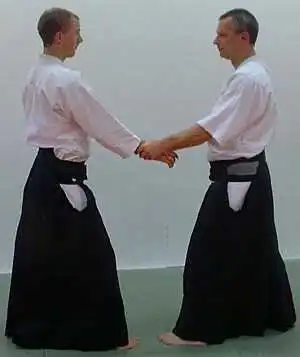 Gyakuhanmi — Reverse relationGyaku Hanmi RelationThe gyakuhanmi relation is when the two opponents have differing arms and legs forward, such as the left on one and the right on the other. This can happen when a left-handed person meets a right-handed one, which is particularly awkward for right-handed persons, since they are in a vast majority. In a katatedori or katadori attack, though, it is the most common relation.
Gyakuhanmi relation
When I lead the attacker's arm up with my one hand, I make a corresponding atemi movement with my other hand toward the attacker's face. Atemi is a strike, but in aikido usually made to distract the attacker and hold him or her off — not to punch anybody down. Still, the atemi has to be convincing, as if a strike was intended, or it will not have the wanted effect. In the atemi, notice that I keep my elbow low and close to my body, so that I don't open for a blow to my side, a very sensitive area of the body. Here the atemi is done rather slowly, because we do the technique in a low tempo. Next, I use the atemi hand in a circular move to get the attacker's arm from below. At the same time as I do this, I take an additional evasive step to his or her other side — or the attacker might be able to hit me with his or her free hand. The circular way of getting the attacker's arm is for reaching it from below, in the regular ikkyo manner. It is also possible to catch it from above, in what would be more of a gokyo manner (that variation you find further down).
Like in every ikkyo ura I do, I start at the omote side, as explained above. With the soft katatedori attack, this is not really necessary, but with harder ones to follow below it is. Remember to stay near the attacker, all through the technique, and to move your arms in front of you, to get the power from your center. The downward spin should be possible to do in a very relaxed way. It also helps a lot to pull the attacker's wrist ahead in the movement, and not use too much force on the attacker's upper arm. The feeling of the movement should be that you extend the attack onward in a spiral.
Gyakuhanmi katatedori — gokyo omoteFor comparison, I here show the gokyo way of grabbing the attacker's wrist from above. Although it should formally be called a gokyo, not an ikkyo, many use this in their ikkyo — including me, every now and then. No big deal. Sometimes this approach is more convenient, sometimes the other one, with your hand coming from below.When you grab the attacker's wrist, be careful not to lift your elbow too high, or the attacker might be able to strike you in your side, which is very sensitive. You don't have to be fully protected, you just need to avoid showing a big opening, and the attacker will not get the impulse to hit. Also, you need to make an additional evasive step at the same time as you grab the attacker's wrist. At the end of the technique, you can use the grip you have on the attacker's wrist to make the pinning more effective. You turn the attacker's hand toward him or her, and then twist it slightly forward. I don't do that on this video clip, instead I let go to make the normal ikkyo pinning, with my hands on both sides of the attacker's elbow. I should not, really. In some of the following clips, though, I use the wrist pinning.
Ryotedori — omote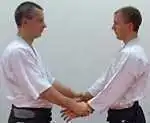 Ryotedori can really be handled like gyakuhanmi. The aikido movements and techniques are so fashioned that it rarely matters if you are grabbed by one wrist or both. Just don't worry about it, and it will be solved on the way through the technique.
Ryotedori can really be handled like gyakuhanmi. The aikido movements and techniques are so fashioned that it rarely matters if you are grabbed by one wrist or both. Just don't worry about it, and it will be solved on the way through the technique.Anyway, in this video clip I show a slightly different way of doing ryotedori ikkyo, than used above on the gyakuhanmi katatedori. This is not necessary, the previous way works fine, but it's a good introduction to a way of solving katadori and munedori, grabs that are significantly more difficult to handle than katatedori and ryotedori. It starts like the katatedori version, with an evasive step to one side, and extending the attacker's arm forward on the other side, at the same time as doing an atemi. Notice that the atemi movement is not hindered at all by the attacker's grip on that wrist. It's because of its semi-circular move, starting out from the attacker's center and around to his or her face. Next, you spin your hand around in a spiral movement toward the attacker, to place it on his or her upper arm — not the elbow, nor the lower arm. I'm afraid that this hand movement is a bit out of view in the angle of this video clip, but hopefully you can figure it out. It is much more visible in the katadori clip below. The attacker will lose his or her grip on your other wrist, about midway through the technique, as you can see on the video clip. Your atemi hand helps in this, with its angle and with its continued push upward and toward the attacker. You push your arm free on the thumb side of the grip, which is the weakest point of it. Notice that I apply the wrist lock at the end of the technique, simply because my grip on the attacker's hand easily allows it. Ryotedori — uraWe missed making a video clip of the ura version, but there's no mystery to it. I do as with every other ura: I start on the omote side, and then go to the attacker's rear. You see it on the techniques above and below. Also, ryotedori ura can be found in the suwariwaza and hanmihandachiwaza sections.
Katadori — omote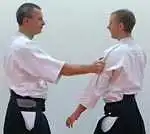 Katadori can be quite tricky, especially if the attacker has a firm grip. Preferably, you should start the technique before the attacker has reached such a grip, but it is also important to practice from a gotai position, where the attacker has a good grip by your shoulder. The grip should not be on top of the shoulder — I've seen many aikido students do that — but by the side. Otherwise the attacker cannot hope to control your arm in the least, and the grip is next to pointless.
Katadori can be quite tricky, especially if the attacker has a firm grip. Preferably, you should start the technique before the attacker has reached such a grip, but it is also important to practice from a gotai position, where the attacker has a good grip by your shoulder. The grip should not be on top of the shoulder — I've seen many aikido students do that — but by the side. Otherwise the attacker cannot hope to control your arm in the least, and the grip is next to pointless.With your first evasive step, your body turn and arm movement, you should extend the attacker's arm well, to make him or her lose balance and get the arm straightened. This makes the grip much weaker. It is also good if you push with your arm on the hand, so that its wrist is twisted, pointing outward, which also weakens the grip considerably. Then you spin around with your hand and place it on the attacker's upper arm, just as in ryotedori above. Here you can see that movement rather well. It is circular, and at the same time advancing toward the attacker's face. The spiral nature of it makes it strong, although you don't apply much muscular force. Also, it makes it hard to resist for the attacker, since it is difficult for his muscles to find a direction in which to work, to counter it. The rest of the technique is business as usual. On this video clip, you can see the wrist lock pretty well. Observe that to have additional force in pressing the attacker's hand toward him or her, you should let your lower arm lie on the floor, in line with the attacker's arm.
Ryokatadori — omote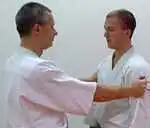 Ikkyo on ryokatadori, when grabbed on both shoulders, is done exactly the same as katadori, when only one shoulder is grabbed. This is the case with most aikido techniques, not just ikkyo.
Ikkyo on ryokatadori, when grabbed on both shoulders, is done exactly the same as katadori, when only one shoulder is grabbed. This is the case with most aikido techniques, not just ikkyo.By the taisabaki twist of your body, and the push with your hand at uke's wrist, uke is pulled forward. Then, you can easily enter on uke's other side, without that shoulder grip stopping you. If there is no pull, though, uke's arm will remain straight and strong, and you can't enter to that side. It's important that you don't just turn in front of uke, but to the side — out of line of uke's direction forward. As you proceed with the ikkyo, uke will lose the second shoulder grip (the one you don't do ikkyo on), because of how you enter and how both you and uke turn. For additional details, see katadori above.
As you proceed with the ikkyo, uke will lose the second shoulder grip (the one you don't do ikkyo on), because of how you enter and how both you and uke turn. For additional details, see katadori above.
Munedori — omote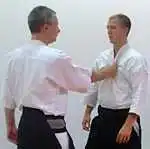 The munedori is pretty much like the katadori, but can be even more tricky on a strong grip. You really have to extend the attacker's arm in the first movement, and make sure that his or her wrist is twisted outward. If you do this arm move with speed and power, you may get free of the grip just by that — but the attacker should watch out, because it is dangerous to his or her nails.
The munedori is pretty much like the katadori, but can be even more tricky on a strong grip. You really have to extend the attacker's arm in the first movement, and make sure that his or her wrist is twisted outward. If you do this arm move with speed and power, you may get free of the grip just by that — but the attacker should watch out, because it is dangerous to his or her nails.When you spin your hand around to press on the attacker's upper arm, make sure that your body forms a long and powerful line in that direction. The movement is very similar to the old olympic sport of shot-putting. If you do this properly, you will surely release yourself from the attacker's grip. On this clip I do it slowly and gently, but to make sure of getting free, you should make it with a decisive and sudden push. When you make this push, your other hand should be ready to catch the attacker's hand by the wrist. You can grab it beforehand, but a good grip on it you can only get after the attacker's grip on your keikogi is released. Don't try to get the attacker down on the floor until you have accomplished this, or you may end up in a worse situation than the one you had in the beginning.
Again, notice that I start with an omote entrance, before going toward the attacker's rear. In this type of grip, the attacker's arm is very difficult to lead into the ikkyo movement, if you go directly to the attacker's rear. On strong people, it is simply impossible.
Ryosodedori — omote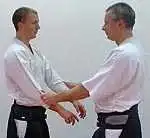 Sodedori is a grip on the sleeve, ususally by the end of it, and ryosodedori is gripping both sleeves. This is an attack form not practiced that often in aikido, although it is interesting because of the lack of direct bodily contact in the grip.
Sodedori is a grip on the sleeve, ususally by the end of it, and ryosodedori is gripping both sleeves. This is an attack form not practiced that often in aikido, although it is interesting because of the lack of direct bodily contact in the grip.To make sure that uke is steered properly through the technique, you have to make accentuated movements with your arms. Take extra care in forming the curves and spirals of ikkyo, especially at the beginning of the technique, before your hands get in contact with uke's arm. Also, make sure to extend properly upward, for uke to lose the sleeve grips. Otherwise, the technique is done in quite the same way as katatedori and katadori. Ryosodedori is not different from sodedori, which is why only the former is included here. As you proceed with the ikkyo, uke will lose the second sleeve grip (the one you don't do ikkyo on), because of how you enter and how both you and uke turn. Unfortunately, my sleeves are a little short on this video clip, for the sodedori situation really to be evident. You don't change the technique at all, when you have longer sleeves, but you may find it a little more difficult, because of the grip being further down on your arm.
As you proceed with the ikkyo, uke will lose the second sleeve grip (the one you don't do ikkyo on), because of how you enter and how both you and uke turn.
Ryohijidori — omote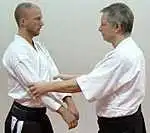 It takes some strength to control somebody by hijidori, the elbow grip, and ryohijidori, both elbows. On the other hand, somebody with that strength can by this grip keep the other person in a pretty good lock — provided that kicks are avoided. Normally, though, it's difficult to keep such a grip.
It takes some strength to control somebody by hijidori, the elbow grip, and ryohijidori, both elbows. On the other hand, somebody with that strength can by this grip keep the other person in a pretty good lock — provided that kicks are avoided. Normally, though, it's difficult to keep such a grip.Hijidori, just grabbing one elbow, is quite meaningless, and therefore rarely practiced. Anyway, ikkyo is done exactly the same on hijidori as on ryohijidori. Ikkyo is done in the same way as with for example ryokatadori and ryosodedori. Even when the elbows are locked in a strong grip, you can move your lower arms easily. Starting with them, you extend uke's direction forward, and then it is possible to move also the elbows freely. As you proceed with the ikkyo, uke will lose the second elbow grip (the one you don't do ikkyo on), because of how you enter and how both you and uke turn.
As you proceed with the ikkyo, uke will lose the second elbow grip (the one you don't do ikkyo on), because of how you enter and how both you and uke turn.
Yokomen uchi — omote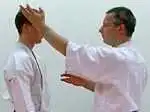 Against yokomen, most aikidoka enter at the same side as the yokomen is coming from, blocking it on the inside. I do not, for several reasons. First of all, meeting the yokomen this way is a collision of forces, and this attack can be fiercely strong. Secondly, in the sword arts from which the attack comes, there is little difference between shomen and yokomen, so there is not much room for slicing in between the attacker's arm and head. You can see that on the video clip, where Tomas attacks with a correctly narrow yokomen, not much different from shomen at all.
Against yokomen, most aikidoka enter at the same side as the yokomen is coming from, blocking it on the inside. I do not, for several reasons. First of all, meeting the yokomen this way is a collision of forces, and this attack can be fiercely strong. Secondly, in the sword arts from which the attack comes, there is little difference between shomen and yokomen, so there is not much room for slicing in between the attacker's arm and head. You can see that on the video clip, where Tomas attacks with a correctly narrow yokomen, not much different from shomen at all.It has become so that many aikidoka attack in too much of a roundabout way with their yokomen, to make this risky type of entrance reasonably trustworthy — but that's disastrous in the long run. We can't make our attack techniques worse, just so that we will be able to defend incorrectly against them. When the yokomen is intended to copy the sword art attack with the same name, then it has to be done accordingly, deviating little from the shomen in the extension of the arm to the side. On the other hand, if it is supposed to be an unarmed attack with the hand to the temple, then one really needs to go to the side with the elbow and make the yokomen strike a horizontal semi-circle — approximately from one's own temple to that of the defender. This technique exists in karatedo. Whether it's the kendo or the karatedo version of the yokomen attack, the defense shown on this video clip should work fine. So it also does on a boxing style hook or swing punch from the side. Actually, you can do the same when the attack is the karatedo roundhouse kick mawashigeri. Observe that you should keep your elbow low, when doing the circular parry movement toward the attacking arm. Otherwise you are too unprotected on your side, which is very sensitive. And don't try to block or stop the attack — a proper yokomen, whether kendo or karatedo, is much too forceful to be stopped. Instead, the parry movement is to extend the attack forward, beyond the attacker's zone of balance. You use a flexible wrist, so that the hand is angled outward automatically, when connecting to the attacker's arm. Then you pull the attacker's arm onward, in the attacker's direction, not by gripping it, but by making your hand sort of sticky. This is achieved by a softness in your arm and hand, so they connect well to the attacker's arm, and don't move beyond the attacker's wrist. Your hand should easily sort of lock to the attacker's wrist, because where his or her hand begins, it widens. So, your hand stops at the corner between the attacker's wrist and hand. I think that you can see it on the video clip, if not very clearly. When you move in with the big vertical ikkyo circle, be sure to make it a habit that the attacker's hand is not in front of you, but to your side — otherwise you might do all kinds of damage to yourself if the attacker holds a knife or a sword. You bring the attacker's hand down to the side of your body, where a weapon does not risk to harm you. It's a good reflex to have.
Oh, just one more thing: when you step toward the attacker's rear, go so near that you practically move under his or her arm. Otherwise it is hard to have good control of the attacker, and hard to avoid a knife or a sword in his or her hand.
Stefan Stenudd
IKKYO COMPLETE
AIKIDO PRACTICEIntroductionAikido Techniques — all the basic movesAttacks in Aikido
Tantodori — knife defenseAikiken — aikido sword techniquesJo 31 Kata in four directionsAikibatto sword and staff exercisesAiki — joining energiesKi exercisesAikido Video ClipsAikido PhotosMy aikido dojo in Malmö, SwedenMy aikido seminarsAIKIDO THEORYMy Aikido BioAikido GlossaryTanden, the CenterAikido InksAikido as Self-DefenseRunning a DojoAikido is TrueOsensei and EinsteinAikiWeb ColumnsAikido Books ReviewedDie deutsche Version meines Aikido-Buches onlineAikido på svenskaAbout CookiesMy Other WebsitesCREATION MYTHSMyths in general and myths of creation in particular.
TAOISMThe wisdom of Taoism and the Tao Te Ching, its ancient source.
LIFE ENERGYAn encyclopedia of life energy concepts around the world.
QI ENERGY EXERCISESQi (also spelled chi or ki) explained, with exercises to increase it.
I CHINGThe ancient Chinese system of divination and free online reading.
TAROTTarot card meanings in divination and a free online spread.
ASTROLOGYThe complete horoscope chart and how to read it.
MY AMAZON PAGE
MY YOUTUBE AIKIDO
MY YOUTUBE ART
MY FACEBOOK
MY INSTAGRAM
MY TWITTER
STENUDD PÅ SVENSKA
|
 Most aikidoka bring the attacker down, by pulling downward with the arm that has been grabbed, but I go the opposite way — upward. This is to make it more in line with other gyakuhanmi relation techniques, and also because in ikkyo you do anyway need to get the attacker's arm up at first, and not down. So, it shortens the move, and also avoids the risk that the attacker will resist having his or her arm pulled up.
Most aikidoka bring the attacker down, by pulling downward with the arm that has been grabbed, but I go the opposite way — upward. This is to make it more in line with other gyakuhanmi relation techniques, and also because in ikkyo you do anyway need to get the attacker's arm up at first, and not down. So, it shortens the move, and also avoids the risk that the attacker will resist having his or her arm pulled up. Aikido Principles
Aikido Principles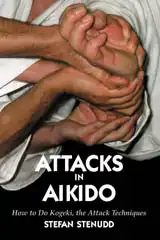 Attacks in Aikido
Attacks in Aikido Aikibatto
Aikibatto
